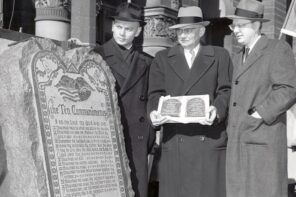Harold Camping is at it again. Turns out the end of the world, scheduled for last Saturday, May 21, 2011, was not, after all, the end of the world. Or maybe it was. Camping is saying now that it was an “invisible judgment day” and that the revised end-time date is October 21, 2011, five months hence.
For any student of American history, all of this sounds eerily familiar—right down to the revision of dates. American history is littered with predictions about the end of the world. When I was writing my chapter on Billy Graham’s visit to Central Park in September 1991 for Mine Eyes Have Seen the Glory, a group of Korean evangelicals were excitedly proclaiming the end of the world on October 28, 1992. On Good Friday 1878, Charles Taze Russell of Allegheny, Pennsylvania, gathered a group of his followers on the Sixth Street Bridge in Pittsburgh to await their translation into heaven. Russell later denied being there; Pittsburgh newspapers insisted otherwise. He claimed in retrospect that 1874 had been the moment of Christ’s “invisible return.” His movement was called the International Bible Students Association, later renamed the Jehovah’s Witnesses.
But the most famous end-of-the-world prediction, and the one which closely parallels Camping’s prediction, occurred early in the nineteenth century.
William Miller was a farmer and self-anointed Bible interpreter from Low Hampton, New York, near Lake Champlain. Whereas Camping’s prediction (as I understand it) was based on his dating of Noah’s flood, Miller devised a complex numerological formula based, at least in part, on the reign of Artaxerxes and the “seventy weeks” mentioned in the book of Daniel in the Hebrew Bible. All of that computed to sometime between March 21, 1843, and March 21, 1844.
With the help of a publicist, Joshua Himes, Miller garnered thousands of followers; at least fifty thousand according to some estimates. Many, like Camping’s followers, left their jobs and dispossessed themselves of earthly goods in preparation for the end. So fevered were the speculations that Horace Greeley, publisher of the New-York Tribune, published a special edition of his newspaper on March 2, 1843, to refute Miller’s calculations.
When the end of the world did not materialize as predicted on March 21, 1844, Miller—like Camping—was disconsolate. But a remnant of Miller’s followers finally persuaded him to go back to his Hewlett-Packard and revisit his calculations. Sure enough, Miller had failed to account for a “tarrying time.” He set a new date: October 22, 1844—just one day and 168 years off from Camping’s new date.
By the time October 23, 1844, dawned, Miller’s followers were disillusioned and soon scattered. Some eventually formed themselves into the Advent Christian Church or the Seventh-Day Adventist Church. But Miller himself died lonely and forgotten in 1849, five years after the “end of the world.” October 22, 1844 is still known in Adventist circles as the “Great Disappointment”—capital G, capital D.
Harold Camping claims to know his Bible, although that claim must surely be questioned now, even by his most ardent followers. He might have been better served by knowing at least a smidgen of history too.




